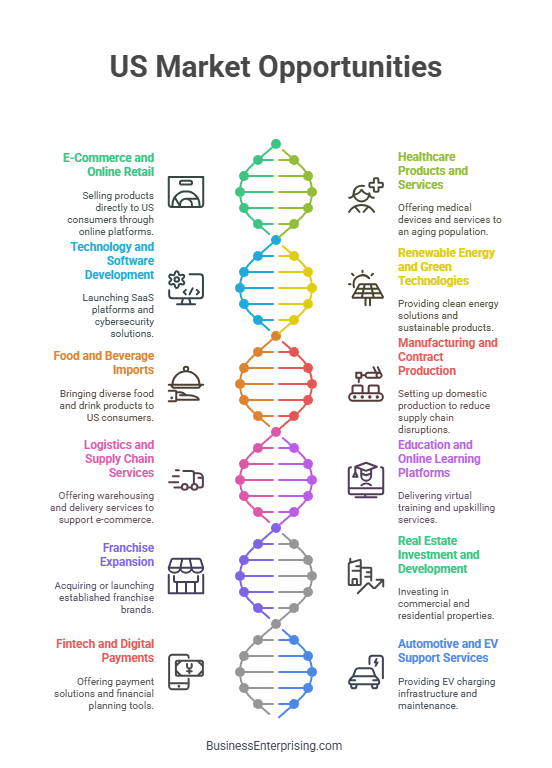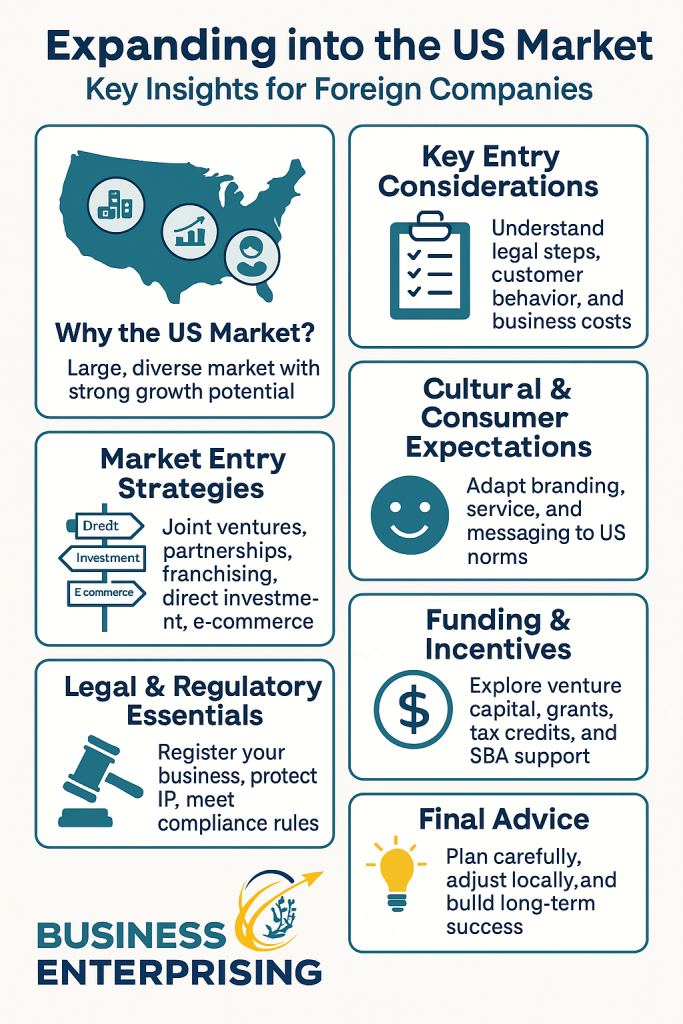
The US offers one of the largest and most diverse markets in the world. Therefore, the opportunities span across industries, cities, and customer types. Additionally, the availability of resources and funding can help support your expansion. You should still approach the move with clear goals and realistic expectations.
You’ll need to consider several key areas before making decisions. For example, legal requirements differ by state and business type. Additionally, market research helps you understand demand, competition, and pricing trends. These steps take time, but they make your plan stronger and more focused.
However, entry strategies vary. Some companies use joint ventures or partnerships. Others launch through e-commerce or direct investment. Therefore, your entry method should match your budget, goals, and industry. You should evaluate all options before choosing a direction.
Marketing also plays a big role. US consumers expect fast service, clear messaging, and easy online access. Therefore, your branding and communication must reflect local norms. Additionally, customer service should be responsive and consistent.
If you’re planning to expand, start with the basics. Build a plan that fits your resources and adjusts to the US market. Taking the time to prepare increases your chances of a strong launch. You don’t need to rush. What matters most is getting it right.
Understanding the US Market Landscape
Understanding the US market starts with identifying its key economic sectors. These include technology, healthcare, retail, manufacturing, and financial services. Each sector presents different growth patterns, customer needs, and entry barriers. Therefore, your success depends on targeting the right segment based on your product or service.
The United States is a consumer-driven economy. Consumers expect convenience, fast delivery, and personalized experiences. However, price sensitivity also plays a role depending on the industry. You should study how customers make purchasing decisions and what motivates repeat buying. Additionally, reviews and brand trust influence many purchasing habits.
Regional variations matter as well. Buying habits in California differ from those in Texas or New York. For example, sustainability might be a bigger factor on the West Coast. Meanwhile, price and practicality may drive sales in the Midwest. Therefore, customizing your approach for each region can improve results.
Additionally, population density, income levels, and cultural influences vary by area. This means your marketing strategies must also change. It’s not only about what you sell, but how and where you promote it. For instance, digital ads may work well in urban centers but less so in rural markets.
You should also consider economic trends and labor markets. Some regions offer better logistics, tax benefits, or workforce availability. These factors can affect cost, speed, and profit margins. Therefore, planning your operations with these details in mind supports better outcomes.
Understanding these dynamics gives your business a strong start. If you’re looking for business opportunities in the US market, study these patterns first. They’ll help you make smarter choices before launching your brand. Carefully analyzing this information will guide your decisions and reduce your risk.
Legal and Regulatory Considerations for Foreign Entities
Expanding into the US means following a specific set of legal and regulatory steps. You’ll need to register your business correctly. Most foreign companies choose to form a corporation or limited liability company. The process includes choosing a state, filing paperwork, and appointing a registered agent.
Additionally, you may need a visa or work permit. The right visa depends on your role and the type of business activity. Therefore, it’s smart to understand which visa category applies to you. Some common options include investor or business-related visas. These usually require proof of funds and business plans.
You should also protect your intellectual property early. Filing for trademarks, copyrights, or patents helps prevent others from using your brand or ideas. However, US protection is not automatic. You must file your claims with the correct agency and follow up if disputes arise.
Compliance regulations vary by industry and location. Therefore, you need to research what rules apply to your specific business. Common areas include taxes, employment law, product labeling, and consumer protections. Additionally, some sectors may require special licenses or permits.
Ignoring regulations can lead to fines or legal issues. That’s why you must stay current with changes in law. Regular audits and working with legal professionals can help you meet your obligations. Additionally, strong internal policies support ongoing compliance.
Understanding these rules helps you avoid delays and costly mistakes. Before you explore business opportunities in the US market, cover your legal basics. Doing so makes your entry more efficient and lowers your risk. Taking the time to plan legally gives your company a better start.
Market Entry Strategies: Choosing the Right Approach
Choosing the right market entry strategy depends on your goals, resources, and risk tolerance. Each approach has different advantages and limits. You should evaluate your options carefully before launching operations.
Joint ventures allow you to work with a local partner. This can help you understand the market faster and share the financial risk. However, it may also reduce your control. Therefore, you must define clear roles and responsibilities from the beginning.
Additionally, partnerships offer a way to share expertise and local knowledge. These arrangements may be informal or structured with legal contracts. Either way, strong communication is key. You should pick a partner whose goals align with yours.
Franchising is another option, especially for consumer brands. It allows you to grow quickly using local operators. However, you must provide training, branding, and ongoing support. Therefore, franchising works best when your business model is proven and repeatable.
Direct investment gives you full control but also involves more risk. You’ll need to set up operations, hire staff, and manage logistics. Additionally, this approach often requires a larger budget and a long-term view.
E-commerce offers a low-cost entry model. Selling online lets you test demand without opening physical locations. Therefore, it’s ideal for new brands or those with limited capital. You can use marketplaces or your own website to reach US buyers.
Each of these strategies offers access to business opportunities in the US market. The best choice depends on your product, experience, and goals. By selecting the right model, you’ll reduce risk and improve your chance of success. Make sure your strategy supports both short-term sales and long-term growth.
Navigating Cultural and Consumer Expectations
Understanding cultural norms and consumer expectations is essential when entering a new market. The US has specific preferences you must recognize. If you ignore these, your brand may struggle to connect with buyers.
American consumers value clarity, speed, and convenience. Therefore, your messaging should be direct and easy to understand. Avoid complex language or regional expressions that may confuse your audience. Additionally, highlight benefits quickly since most people skim content online.
Your brand tone should feel approachable and trustworthy. However, it also needs to match your product and target demographic. You should test different tones and see which gets better engagement. Customer feedback can help you adjust.
Additionally, customer service plays a big role in loyalty. US buyers expect fast responses, clear return policies, and ongoing support. Therefore, it’s smart to train your team in common US service practices. Friendly, helpful communication makes a strong impression.
Visual branding also matters. Colors, fonts, and imagery should feel familiar to the market. However, you don’t need to lose your identity. You can keep your brand’s core while adjusting it for US buyers. This balance helps you stay consistent while appealing to local tastes.
Consumer expectations differ by region, too. For example, buyers in large cities often want speed and tech-based solutions. Meanwhile, rural customers may prioritize value and personal service. You should adapt based on where and how you sell.
Meeting cultural expectations supports stronger brand loyalty. It also improves your chances of long-term success. If you’re exploring business opportunities in the US market, learn what buyers expect. Adjusting your brand and service to meet those needs is a smart first step.
Funding and Financial Incentives Available to Foreign Companies
Access to funding is one of the biggest concerns for foreign companies expanding into the US. Fortunately, you have several options to consider. These can lower your financial burden and improve your ability to scale quickly.
Venture capital is a common choice for fast-growth companies. Many US investors look for new products and untapped markets. However, you must show strong potential and a clear business model. You should also prepare detailed financials and projections.
Additionally, government grants may be available depending on your industry. These grants support innovation, technology, or job creation. While they’re competitive, they can reduce early-stage expenses. Therefore, you should explore federal, state, and local opportunities.
Tax incentives can also support your expansion. Some states offer credits for hiring, training, or locating in targeted areas. Additionally, certain industries may receive tax breaks based on their activities. You should check what each region offers before choosing a location.
The Small Business Administration may also help. While SBA programs favor US-based firms, you can still benefit if your business meets certain criteria. Some programs offer loan guarantees or business support services. Therefore, it’s worth researching their options.
Funding is often the barrier that slows expansion. However, by knowing your options, you can plan smarter and reduce early-stage risks. If you’re seeking business opportunities in the US market, don’t overlook local funding sources. Combining outside capital with government programs can give your business a stronger start. Use these resources to increase flexibility and protect your cash flow.
Digital Marketing and E-Commerce Opportunities
Digital marketing offers a direct way to reach US buyers without large upfront costs. You can promote products, build trust, and grow sales. However, your strategy must match local expectations and habits to work well.
Online sales platforms give you an easy entry point. Sites like Amazon, Walmart, and Etsy already attract millions of shoppers. Therefore, using these channels helps you test products before investing in your own store. Additionally, they offer tools to manage orders, returns, and reviews.
Your success also depends on how people find your business. Search engine optimization helps you appear in local search results. Therefore, you should research keywords, update content regularly, and optimize product listings. SEO works best when you combine it with other tactics.
Additionally, social media is a low-cost way to connect with US consumers. Platforms like Instagram, Facebook, and TikTok support both ads and organic content. You can build trust by sharing product tips, customer stories, and behind-the-scenes posts. However, your tone should reflect local norms and language.
Localized strategies matter more than you might think. US buyers expect fast replies, clear pricing, and easy returns. Therefore, you should adjust your policies and content for the market. Small changes in copy or shipping options can improve results quickly.
Digital tools give foreign businesses a strong chance to succeed. If you’re exploring business opportunities in the US market, focus on online growth first. By combining strong content, smart ads, and regional focus, you can reach buyers where they already spend time. This approach builds awareness and sales without needing a physical location.
Conclusion
Expanding into a new market requires planning, research, and flexibility. The US offers scale, diversity, and access to global buyers. However, you must understand the rules, preferences, and risks before you move forward.
Each decision you make—from structure to strategy—affects your long-term success. Therefore, take time to assess your options carefully. Additionally, stay open to feedback and adjust your approach as needed. Small changes can have a big impact on your results.
You should also stay consistent with your goals and branding. However, be ready to tailor your message for regional or cultural preferences. This helps you build stronger relationships with your audience. Additionally, a local focus can support faster growth.
Finding the right support also matters. Legal advisors, consultants, and local partners can help reduce mistakes. Therefore, you should build a strong team before launching. Starting with the right structure can prevent delays and improve your position.
The US market is highly competitive but full of potential. If you prepare well and act strategically, your business can grow. Additionally, digital tools and funding programs can lower your entry barriers. These resources give you an edge in a crowded space.
You’ll find many business opportunities in the US market across industries and platforms. Therefore, take the time to understand where your offer fits. With the right strategy and support, your company can build momentum. Stay focused, keep learning, and commit to steady progress. Over time, these habits will help you succeed.



